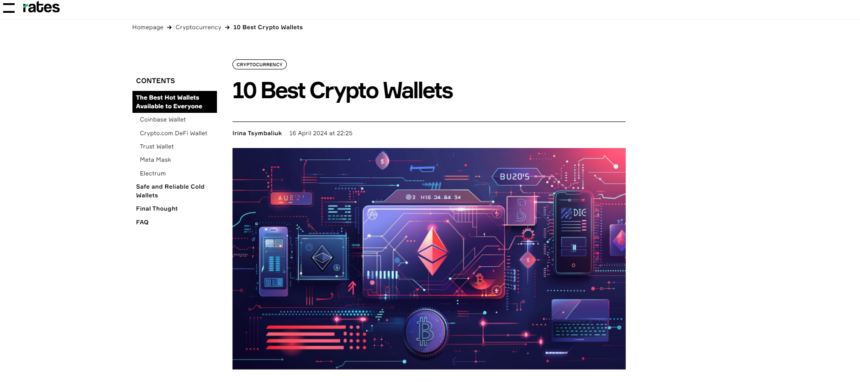The popularity of a cryptocurrency is directly related to its market capitalization. The more expensive assets are, the more stable they look to investors, despite frequent price fluctuations. Crypto is considered a risky investment, but it allows you to make good money, which attracts many to this area. This article is dedicated to the most promising cryptocurrencies in 2024, which will reveal to you more information about working with cryptocurrency, traditional currencies, and the relevance of using the Rates.fm – aggregator of currency rates in the modern financial world.
Which Cryptocurrencies Are Suitable For Investment in 2024?
For those who want to gain experience investing in cryptocurrencies and using crypto exchanges such as Coinbase or Binance, promising coins that can show good growth in the near future or within 1-2 years are suitable. If we compare new and old cryptocurrencies such as Bitcoin, Ethereum, and Solana, fundamental coins are more stable. That is, they fall less, but also grow weaker in different phases. New altcoins are capable of showing more serious gains on the rise, so during this period, it makes sense to invest in them. Let’s look at the different types of cryptocurrencies to invest in 2024.
Ethereum
Ethereum ranks second in the world crypto ranking and actively competes with Bitcoin. The number of these coins is not limited.
Ethereum operates on the blockchain platform of the same name, which is widely used for decentralized transactions. The more successful smart contracts or applications are created on the network, the more stable and valuable ETH becomes.
Pros of ETH:
- A leader in the blockchain field, a large popular platform for any decentralized projects.
- There is no limit on the issue of coins.
- Availability of algorithms to protect against inflation.
- A simple and environmentally friendly network mechanism.
- Transparency of all transactions, anonymous transactions.
Cons of Ethereum:
- The need for constant updating so that network performance does not drop.
- Lack of clear rules for asset ownership and legal protection.
- High level of competition in the market.
StarkNet (STRK)
StarkNet was developed by Israeli blockchain company StarkWare to scale Ethereum. Starknet is a layer 2 network that makes ETH transactions faster, cheaper, and more secure using zk-STARKs technology.
The name of the cryptocurrency “StarkNet” and the network “StarkChain” comes from the name of the creator company. The native cryptocurrency STRK appeared in February 2024.
Pros of StarkNet:
- Increased scalability.
- Low commissions.
- Enhanced protection against hacker attacks.
- Fast execution of smart contracts.
Cons of STRK:
- Limitations of functionality, for example, the inability to support certain types of smart contracts used in the Ethereum network.
- Dependency on the ETH system.
Hashflow (HFT)
Hashflow is a decentralized exchange that allows users to trade a variety of cryptocurrencies without having to pay high fees or make a deposit.
The Hashflow project was launched in April 2021 by a team of experts who previously worked for giants such as Microsoft, Google, and Amazon. Its own coin, HFT, is traded on 29 exchanges.
The system offers users three main options: a secure DEX exchange with a commission-free exchange, an NFT market, and game management.
Pros of Hashflow:
- Complete absence of transaction fees.
- A convenient pricing method, the user pays exactly the price that you see on the exchange, without taking into account the change in exchange rate at the time of the transaction.
- Ensure greater privacy through direct transactions without intermediaries.
- Supports trading of almost any digital asset.
- High performance of the blockchain.
Cons of HFT:
- Underdevelopment of the ecosystem.
- Low liquidity.
- Susceptibility to market manipulation.
Python Network (PYTH)
Pyth Network is a Web 3 decentralized application solution for monitoring prices and other financial information used in smart contracts and DeFi applications.
Pyth Network updates prices for a wide variety of assets every 400 milliseconds, and you can also download an archive of data for a specific period. The value of the project is confirmed by the presence of its own Pyth token, which is traded on 35 different exchanges.
Pros of PYTH:
- A wide network of high-precision data providers that are updated regularly.
- Stable receipt of financial information, regardless of external conditions or economic situation.
- High speed of transactions and other operations, up to 4,000 per second.
- Good level of capitalization and prospects of the project in terms of investments.
- The value of the protocol for the development of the DeFi market, which opens up new opportunities to bridge the gap between traditional and decentralized finance.
Cons of Pyth Network:
- The initial stage of development of the project and its native token, there is no history to analyze.
Sui (SUI)
SUI is a platform for layer 1 smart contracts. It provides unique low latency and scalability for simple use cases such as payment transactions. Sui is designed to process most transfers in parallel, which helps to use resources more economically for monetary transactions.
The Sui testnet was launched in August 2022, and the main one went live in 2023. The blockchain was developed by the American company Mysten Labs, which is headed by several former top managers of the Meta digital wallet program.
Pros of SUI
- Instant completion of operations with minimal latency.
- Execute up to 120,000 transactions simultaneously thanks to the possibility of parallel processing of operations.
- Low transfer fees.
- Multifunctionality of the token (payment of network commissions, staking, use for payments in ecosystem services, and as a liquid asset on other platforms).
- High level of scalability, suitable for different projects.
Cons of SUI:
- A limited community, Sui is still in its early stages of development.
- Incompatibility with the Ethereum network.
- Instability of the coin (the project is at the development stage, and the cryptocurrency has high volatility).
Ethereum is the most famous project in this article because its release took place in 2015. During this time, many events occurred in the Ethereum ecosystem and, in fact, with the project’s cryptocurrency. Users who are familiar with currency rate aggregators will not have any difficulty understanding the analysis of ETH price volatility.
Final thoughts
In a world where people are accustomed to paying exclusively with Visa and Mastercard cards, a new means of payment with investment potential has emerged – cryptocurrencies. Whether you are in the USA to Belgium, cryptocurrencies are something that can be used anywhere in the world. This opens up great opportunities for investing in these assets, especially since there are so many of them on the market. To learn more about cryptocurrencies, and modern payment systems, and also use the currency rates aggregator, visit the Rates.fm service.






